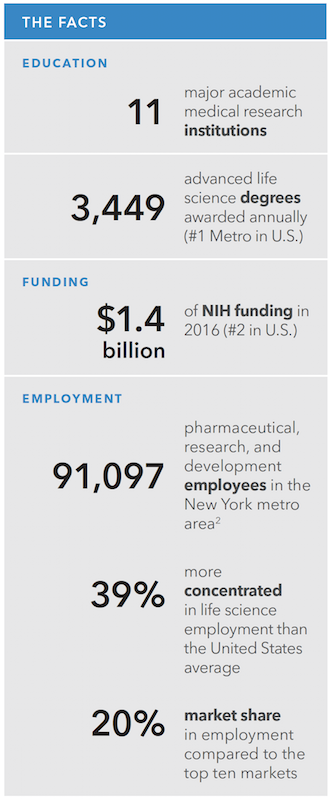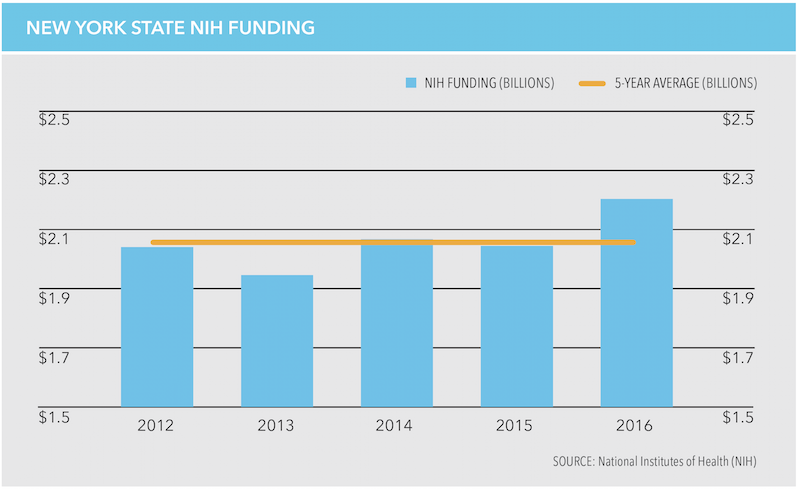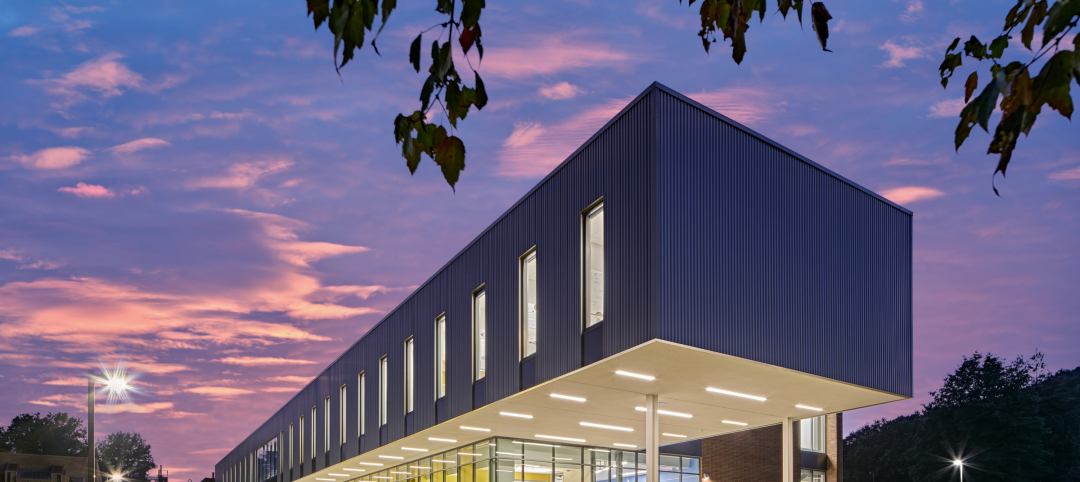Developers Taconic Investment Partners and Silverstein Properties are spending $20 million to renovate the 326,861-sf Movie Lab building in Midtown Manhattan for life science research usage.
The New York Post reports that the Stem Cell Foundation has leased 42,100 sf in this building since 2015. Another 150,000 sf on the top floors of this 10-story building are being upgraded to attract more life science tenants. The building reportedly is changing its name to the Hudson Research Center.
Transwestern, which is marketing this lab space for the developers, has released a special report that portrays New York City as an emerging life sciences hub, where space is tight and development opportunities are multiplying.
New York is already a significant player in this field, by virtue of being home to 11 major academic medical centers, including Weill Cornell Medical College and Albert Einstein College of Medicine. The city also has three of the country’s top 15 hospitals and five of the top 50 medical schools, according to U.S. News and World Report’s latest report card.

New York City is already a leader in life sciences employment and, more recently, available funding. Image: Transwestern
The city also one of the country’s highest concentrations of life-science employees, accounting for one-fifth of the total employment in this sector within the top 10 life science markets.
The problem is shortage of lab space. Transwestern estimates that 100% of the city’s 1.7 million sf of existing life science and research space is occupied. And until recently, New York’s zoning restrictions made it particularly tough for life science companies to build lab space within manufacturing districts—M Zones—that restrict chemical compounding and packaging, the creation of pharmaceutical products and medical appliances, laboratories, research, experimental and testing facilities.
But over the past year or so, market and regulatory changes have made development more conducive for lab science expansion.
Indeed, recent lease transactions have included 49,143 sf at 10 Hudson Yards for Intercept Pharmaceuticals, 30,000 sf at 101 Avenue of the Americas for JLABS (division of J&J Innovations), 19,645 sf at 100 Wall Street for Integra Partners, 11,865 sf at 600 Third Avenue for Turing Pharmaceuticals, and 11,537 sf at 25 West 45th Street for Crossover Health.
More investment capital and funding are flowing into the city for this sector. Out of the $31.3 billion in National Institutes of Health funding awarded nationally in 2016, the New York metro area received $2.7 billion in NIH grants. New York City alone was awarded $1.4 billion, ranking it the second-highest funded city in the country.

More dollars from the National Institutes of Health are flowing into New York State and, particularly, New York City. Image: NIH/Transwestern
Last December, New York Governor Andrew Cuomo unveiled a state-funded life science initiative that includes $250 million in tax incentives for new and existing life science companies, $200 million in state capital grants to further support investment in wet-lab and innovation space, $100 million in investment capital for early stage life science initiatives, and a state match of at least $100 million for operating support from private sector partnerships.
New York City Mayor Bill DiBlasio also has launched a program called LifeSci NYC, which will include a $100 million investment to create a new applied life science campus, $50 million to expand a network of life science R&D facilities, $10 million to expand the network of incubators, $20 million a year in matching funds to support early-stage businesses, and $300 million in tax incentives for commercial lab space.
On the zoning front, in December the Departments of Buildings (DOB) and City Planning (DCP), and the Economic Development Corporation (EDC) issued a clarification memo updating their interpretation of the zoning in the several commercial districts.
The city agencies and the EDC, says Transwestern, “broadened their understanding of the current use group 9A zoning to also include the “synthesis and manipulation of chemical substances, biological matter, and animal models … [that] are integral activities in commercial medical laboratories devoted to research and testing.”
Already, new research and lab spaces are popping up. The Cornell Tech campus on New York City’s Roosevelt Island just opened its first phase. And the 1.17-million-sf Building 77 at the Brooklyn Navy Yard is undergoing a $185 million renovation that could attract lab tenants.
Related Stories
K-12 Schools | Feb 29, 2024
Average age of U.S. school buildings is just under 50 years
The average age of a main instructional school building in the United States is 49 years, according to a survey by the National Center for Education Statistics (NCES). About 38% of schools were built before 1970. Roughly half of the schools surveyed have undergone a major building renovation or addition.
Performing Arts Centers | Feb 27, 2024
Frank Gehry-designed expansion of the Colburn School performing arts center set to break ground
In April, the Colburn School, an institute for music and dance education and performance, will break ground on a 100,000-sf expansion designed by architect Frank Gehry. Located in downtown Los Angeles, the performing arts center will join the neighboring Walt Disney Concert Hall and The Grand by Gehry, forming the largest concentration of Gehry-designed buildings in the world.
Construction Costs | Feb 22, 2024
K-12 school construction costs for 2024
Data from Gordian breaks down the average cost per square foot for four different types of K-12 school buildings (elementary schools, junior high schools, high schools, and vocational schools) across 10 U.S. cities.
K-12 Schools | Feb 13, 2024
K-12 school design trends for 2024: health, wellness, net zero energy
K-12 school sector experts are seeing “healthiness” for schools expand beyond air quality or the ease of cleaning interior surfaces. In this post-Covid era, “healthy” and “wellness” are intersecting expectations that, for many school districts, encompass the physical and mental wellbeing of students and teachers, greater access to outdoor spaces for play and learning, and the school’s connection to its community as a hub and resource.
K-12 Schools | Jan 25, 2024
Video: Research-based design for K-12 schools
Two experts from national architecture firm PBK discuss how behavioral research is benefiting the design of K-12 schools in Texas, Florida, and other states. Dan Boggio, AIA, LEED AP, NCARB, Founder & Executive Chair, PBK, and Melissa Turnbaugh, AIA, NCARB, Partner & National Education & Innovation Leader, PBK, speak with Robert Cassidy, Executive Editor, Building Design+Construction.
Industry Research | Jan 23, 2024
Leading economists forecast 4% growth in construction spending for nonresidential buildings in 2024
Spending on nonresidential buildings will see a modest 4% increase in 2024, after increasing by more than 20% last year according to The American Institute of Architects’ latest Consensus Construction Forecast. The pace will slow to just over 1% growth in 2025, a marked difference from the strong performance in 2023.
Sponsored | BD+C University Course | Jan 17, 2024
Waterproofing deep foundations for new construction
This continuing education course, by Walter P Moore's Amos Chan, P.E., BECxP, CxA+BE, covers design considerations for below-grade waterproofing for new construction, the types of below-grade systems available, and specific concerns associated with waterproofing deep foundations.
K-12 Schools | Jan 8, 2024
Video: Learn how DLR Group converted two big-box stores into an early education center
Learn how the North Kansas City (Mo.) School District and DLR Group adapted two big-box stores into a 115,000-sf early education center offering services for children with special needs.
University Buildings | Dec 8, 2023
Yale University breaks ground on nation's largest Living Building student housing complex
A groundbreaking on Oct. 11 kicked off a project aiming to construct the largest Living Building Challenge-certified residence on a university campus. The Living Village, a 45,000 sf home for Yale University Divinity School graduate students, “will make an ecological statement about the need to build in harmony with the natural world while training students to become ‘apostles of the environment’,” according to Bruner/Cott, which is leading the design team that includes Höweler + Yoon Architecture and Andropogon Associates.
Higher Education | Nov 21, 2023
UPitt at Bradford opens new Engineering & Information Technologies Building
The University of Pittsburgh at Bradford recently opened a new engineering and information technology building that adds urgently needed lab and instructional space to the campus.
















